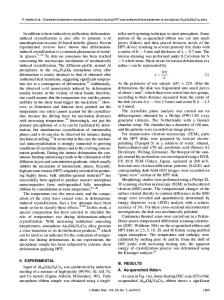Correlation Between Microstructural Architecture and Mechanical Behavior of Single-Walled Carbon Nanotube-Aluminum Compo
- PDF / 1,760,790 Bytes
- 7 Pages / 593.972 x 792 pts Page_size
- 15 Downloads / 276 Views
metal matrix composites (MMCs), high performance reinforcements (such as fibers, whiskers, and particles) are incorporated into the metal matrix to enhance elastic modulus, mechanical strength, and various functional properties.[1] The mechanical properties of MMCs are not only determined by the concentration of the reinforcements, but also depend on their morphology, geometrical arrangement and spacial distribution in the metal matrix.[2] In the past decade, to mitigate the intrinsic conflict between strength and ductility and obtain balanced mechanical
YAN SHI, YANG LU, ZIHONG NI, LEI ZHAO, ZHIQIANG LI, DING-BANG XIONG, and QIANG GUO are with the State Key Lab of Metal Matrix Composites, Shanghai Jiao Tong University, 800 Dongchuan Road, Shanghai 200240, China. Contact e-mail: [email protected] JIN ZOU is with the Materials Engineering and Centre for Microscopy and Microanalysis, The University of Queensland, Brisbane, St. Lucia, QLD 4072, Australia. Manuscript submitted September 2, 2019.
METALLURGICAL AND MATERIALS TRANSACTIONS A
properties, extensive studies have been devoted to the fabrication and characterization of metals and/or MMCs with elaborately tailored microstructures (or ‘‘architectures’’), such as bi-/multi-modal structure,[3–5] gradient structure,[6–8] network/interpenetrating structure,[2,9,10] and nanolaminated structure.[11–14] The general idea is to introduce structural heterogeneity into the composite to alleviate strain localization and thus facilitate uniform plastic flow. Among the above-mentioned approaches, the MMCs with nanolaminated structure are considered as ideal model materials to study the strength-ductility synergy in inhomogeneous microstructures. This is because of the relative simplicity of their structures, and their wide adoption by hard biological materials, where the nanoscaled layer thicknesses render superior strength while the laminated structure provides various deformation and toughening mechanisms.[11–14] In the case of nanolaminated MMCs, carbon nanotube (CNT)-metal composites with sandwiched structure were fabricated, and improvements in mechanical strength and toughness were reported.[11] Nanolaminated nickel carbide (Ni3C)-nickel (Ni) and graphene-aluminum (Al) were developed, demonstrating a synergetic improvement in strength, stiffness and toughness.[13,14] Using a modified powder metallurgy method, we fabricated bulk nanolaminated multi-walled carbon nanotube (MWCNT)-Al,[11] reduced graphene oxide (RGO)Al[12] and RGO-Copper (Cu)[15] composites, where the nanocarbon reinforcements were uniformly distributed at the inter-lamella boundaries, and their structural integrity was well maintained throughout the processing. Macroscopic and microscopic mechanical tests revealed excellent strengthening effect of the nanocarbon and unique plastic deformation mechanisms conferred by the rich interplay between the reinforcement/matrix interfaces and dislocations in the metal matrix.[11,12,16] In this study, we expand our repertoire by fabricating nanolaminated single-walled carb
Data Loading...











